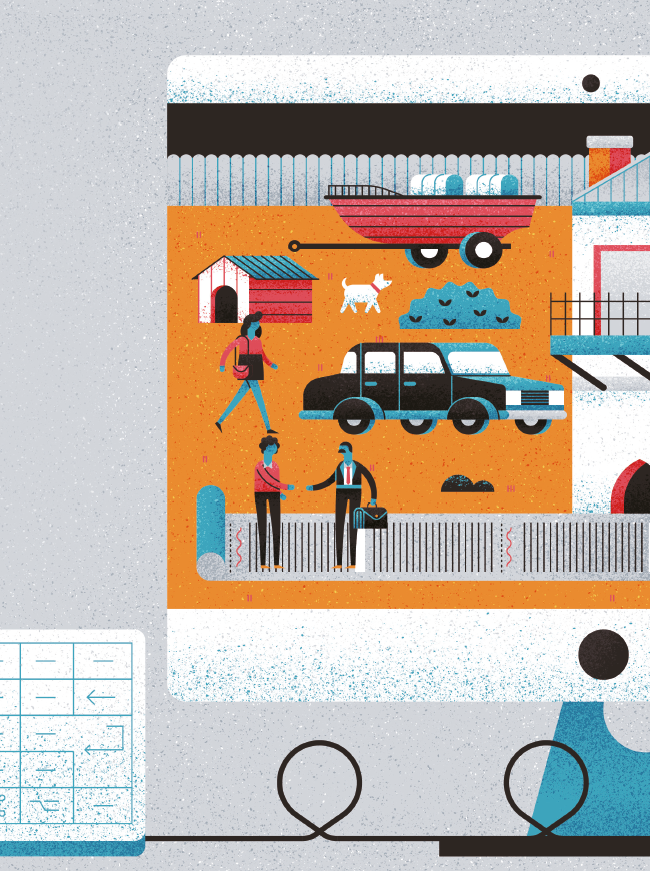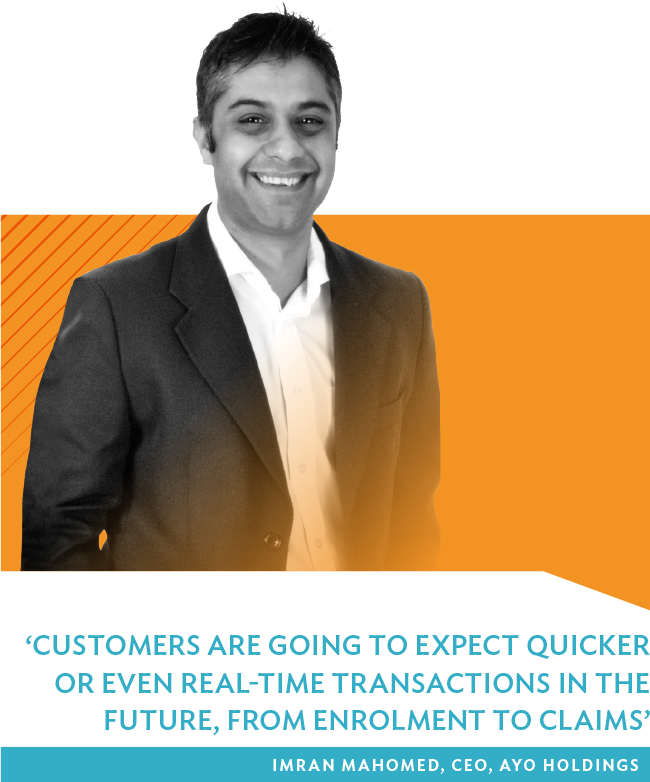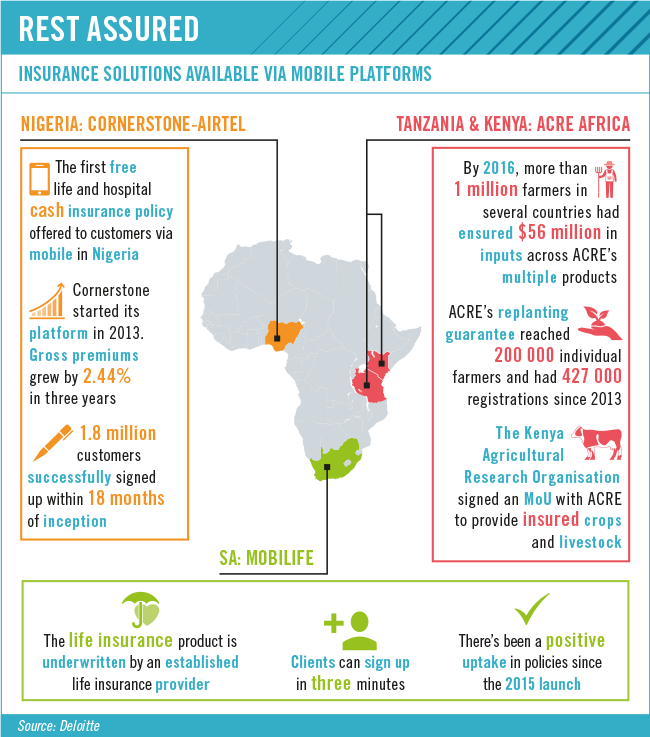The digital revolution and its associated technologies have disrupted many industries. Start-ups and new offerings are now outmanoeuvring once-large companies that have traditionally held a big share of their relevant markets.
A 2016 Accenture survey showed a clear customer preference for digital insurance solutions and a readiness for digital engagement, with 80% of the 1 500 customers surveyed across SA indicating that they were ready to purchase insurance products online.
According to Caroline Theodosiou, a director in the litigation insurance practice at Norton Rose Fulbright, three out of four insurance companies believe that their business is at risk of disruption. However, she says, there are currently ‘only a few truly digital product offerings in the local market’.
In mid-2017, Oliver Bäte, CEO of Allianz, said while opening the 44th Annual Insurance Conference at Sun City that Africa is poised to become a leader in digital insurance. Bäte called the continent ‘digital by nature’, adding that by leveraging the internet and mobile penetration, African countries can leapfrog innovation. ‘African customers will rightfully demand and drive insurance innovation in Africa as they expect offerings and channels to be fully digitalised.’
Bäte argues that customers not only have new expectations, but megatrends – such as artificial intelligence, telematics, wearables and drones – are fundamentally changing the traditional insurance model. ‘Today’s customers will choose a product primarily because it’s easy to use, transparent in terms of price and quality, and personalised. And because it’s available to them via the digital channels they want it from.’
In response to this, Allianz has established what it calls a single digital agenda, budgeting $800 million to orchestrate the digitalisation of its 128-year-old business. In Africa, where the group is present in 16 countries, Allianz has focused its digital activities on increasing customer reach in key markets where insurance penetration is low, and efficiency in markets with higher penetration.
Kevin Wright, executive head of operations and IT at Santam, says that changes in the insurance space over the last decade have included significant investment by insurers into new, modern technologies. ‘For many years, insurers ran traditional mainframe technology, though this has now been replaced with modern, open-architecture systems that are able to integrate with other systems more easily,’ he says.
According to Wright, the company markets and sells its products – Santam and MiWay insurance – through social media channels, including YouTube and Facebook, on a pay-per-click scenario, though it also uses direct and online selling opportunities. It has apps for both brands, and customers can request quotes through these.
Asked whether their customers are happy to purchase insurance products online, Wright says they are content to begin the process online, but that the company sees better sales completion rates when a customer starts online, and it intervenes in the transaction to help them through the process.
‘By the very nature of the industry, insurers ask a lot of questions, and not everybody understands everything that a broker or sales agent in a support centre or call centre would,’ he says. ‘Often, with online transactions, we find that people get half-way and stop. We find that if we can get into that process while they’re online and help them through it, we get a better conversion factor.’
With Infiniti Insurance, clients can insure their houses, furniture, jewellery and cars as well as their businesses, directly through the online platform without once speaking to a consultant – unless they need to, in which case they can click on the ‘help’ button.
The company also has an emergency assist app available for download. Through this, clients can report an accident, summon a tow truck or request medical assistance.
Sharon Paterson, Infiniti Insurance CEO, says the platform is simple and easy to use. It exists as an alternative avenue into the company, to complement the business that comes through its broker network. ‘Most customers these days are adept at using the internet. If you buy your wedding dress online, then surely you would want the convenience of buying your insurance online too,’ she says.
However, Paterson counters, insurance is not a one-size-fits-all product. ‘It is important that clients have the freedom and flexibility to interact with Infiniti in the way that best suits them – hence our online platform. We no longer live in a nine-to-five world and customers expect to be helped immediately. They are hungry for innovation and welcome new ideas and flexible insurance solutions.’
Imran Mahomed, CEO of Ayo Holdings – a joint venture between MMI Holdings and the MTN Group – believes that customers, especially those in the middle to top end of the market, are becoming more sophisticated and use online and digital services more frequently, which has shaped their expectations. He says that while the insurance industry in SA and Africa is somewhat behind other industries as far as digitisation goes, it is catching up.
Ayo has been active in Uganda since early 2017 with two products: Recharge with Care and Send with Care. The latter is also active in Ghana. Recharge with Care provides clients with life and/or hospitalisation cover after an accident when they recharge their MTN airtime. Send with Care enables clients to add cover when they send money to someone else’s mobile money wallet. Both products are fully digital and can be accessed by customers on their mobile phone through USSD – a global system for mobile communication technology that is used to send a text between a mobile phone and an application programme in the network, also referred to as feature codes or quick codes.
Ayo has a website and Facebook page, and Mahomed says the insurer will offer greater functionality online and through an app in due time.
Other companies with a presence in Africa that are leveraging digital innovation to design products and business models that are less reliant on legacy systems include BIMA, Cornerstone, ACRE Africa, and MobiLife.
BIMA delivers its simple but effective life and hospital insurance offering to bottom-of-the-pyramid (BoP) consumers via mobile technology, with cover of up to $1 100 costing as little as $0.30 per month. Cornerstone, in partnership with Airtel, offers Nigeria’s first life and hospitalisation insurance policy to subscribers based on their airtime spend.
ACRE Africa offers insurance to smallholder farmers – individuals who face weather-related risks over which they have no control. Should a farmer register a claim, this is paid out through mobile wallets or as discounts on their next fertiliser or seed purchase (an insurance product called a replanting guarantee). This ensures farmers can replant their crops and avoid a total loss of income.
In SA, MobiLife has simplified the purchasing and managing of life insurance through mobile digital solutions designed for BoP consumers. Traditional life insurance companies terminate insurance policies if payments lapse, but MobiLife’s never-lapse rule exists to protect policyholders. Instead of terminating policies, MobiLife reduces the pay-out amount in the case of premium non-payment.
Moreover, unlike traditional life insurance policies and funeral cover, MobiLife does not pay out a lump sum in cash in the event of death. Rather, it provides beneficiaries with weekly grocery vouchers for a set period. The beneficiaries of the policy receive weekly text messages with a code that enables them to purchase groceries at a range of leading supermarket chains in SA.
Mahomed believes that, while the insurance model itself has not changed that much in the last 10 years, the coming decade will likely bring about material shifts in how insurance is done, with the likes of mobile payments, blockchain and artificial intelligence coming to the fore. He says that companies need to consider how customers are changing. ‘They’re learning quicker, they’re more informed, they’re getting – and becoming used to – a greater digital experience elsewhere, and that’s going to feed into their expectations of the insurance industry,’ he says.
‘Customers are going to expect quicker or even real-time transactions in the future, from enrolment to claims. I think decision-making and engagement will have to follow suit, and we’ll need a much higher level of transparency.’










